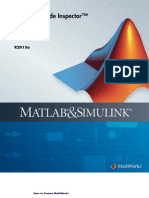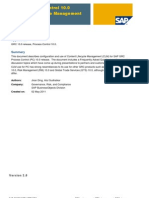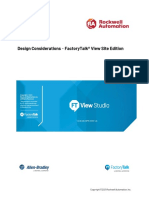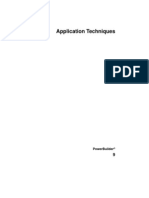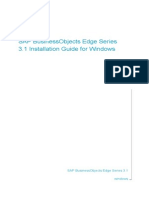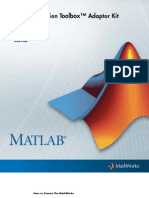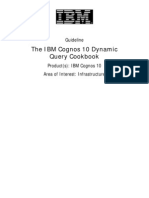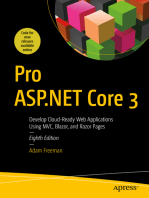Coding Standards (MVC)
Coding Standards (MVC)
Uploaded by
-venom92Copyright:
Available Formats
Coding Standards (MVC)
Coding Standards (MVC)
Uploaded by
-venom92Original Title
Copyright
Available Formats
Share this document
Did you find this document useful?
Is this content inappropriate?
Copyright:
Available Formats
Coding Standards (MVC)
Coding Standards (MVC)
Uploaded by
-venom92Copyright:
Available Formats
Coding Standards for ASP .
Net MVC
India Engineering
Coding Standards for ASP .Net MVC
India Engineering
Document Approval
Name Role Date
Rahul Talim Head- Execution Excellence 15-Jun-18
Revision History
Version Change Description Changed by Date
0.1 Standard draft created PEG 18-Jun-18
1.0 Standard released for internal use PEG 18-Jun-18
Johnson Controls – Confidential Page 1 of 23
Coding Standards for ASP .Net MVC
India Engineering
Index
General Information ................................................................................................................................. 4
Model Recommendations......................................................................................................................... 4
DO separate the model its own project with a distinct assembly ............................................................ 4
DO put all business logic in the model ...................................................................................................... 4
DO put all validation logic in the model.................................................................................................... 5
DO define interfaces for data access ........................................................................................................ 6
DO put all session logic in the model ........................................................................................................ 6
View Recommendations ........................................................................................................................... 7
DO put HTML in Views and Partial Views (not in a controller) ................................................................. 7
DO access data in views using ViewData .................................................................................................. 8
DO enable (auto-generated) client side validation................................................................................... 9
DO insert server-side comments in templates ....................................................................................... 10
DO use HTMLHelper extension methods................................................................................................ 10
Controller Recommendations ................................................................................................................. 10
DO use model binding instead of manually parsing the request............................................................ 10
DO explicitly name views in action methods .......................................................................................... 12
DO use Post/Redirect/Get (PRG) when submitting forms ...................................................................... 12
DO implement HandleUnknowAction and HandleError ......................................................................... 13
Routing Recommendations..................................................................................................................... 13
DO order routes from specific to general when using standard routing................................................ 14
DO use named route mechanism to avoid route ambiguity .................................................................. 15
Extensibility Recommendations.............................................................................................................. 16
DO use filters for adding behaviors ........................................................................................................ 16
Testability Recommendations ................................................................................................................ 17
DO write units tests ................................................................................................................................ 17
Security Recommendations .................................................................................................................... 18
DO guard against common attack vectors .............................................................................................. 18
DO authenticate and authorize users to protect content ...................................................................... 19
Johnson Controls – Confidential Page 2 of 23
Coding Standards for ASP .Net MVC
India Engineering
DO use <%: %> (.NET 4) to protect against XSS attacks .......................................................................... 19
Localization and Globalization Recommendations ................................................................................. 19
DO use ASP.NET special resource folders and resource files ................................................................. 19
Performance Recommendations ............................................................................................................ 20
DO consider partial page updates using AJAX for reducing bandwidth ................................................. 20
DON'T overuse session, instead use TempData for short lived (intra-request) storage ........................ 21
DO use an OutputCache filter for static pages ....................................................................................... 22
DO consider using asynchronous controllers for long running requests................................................ 23
Johnson Controls – Confidential Page 3 of 23
Coding Standards for ASP .Net MVC
India Engineering
General Information
Coding Standard Guideline would help to write reliable, maintainable and efficient code to deliver best
quality software.
The naming conventions, coding standards and best practices described in this document are compiled
from our own experience and by referring to various Microsoft and non-Microsoft guidelines.
Model Recommendations
The model is where the domain-specific objects are defined. These definitions should include business
logic (how objects behave and relate), validation logic (what is a valid value for a given object), data logic
(how data objects are persisted) and session logic (tracking user state for the application).
DO separate the model its own project with a distinct assembly
For applications with a large complex model, it's a good idea to create a separate assembly for the
model to avoid accidently mixing concerns. You can then reference the model assembly in your ASP.NET
MVC project.
DO put all business logic in the model
If you put all business logic in the model, you shield the view and controller from making business
decisions concerning data. You also reap the following benefits:
Less duplicated business logic.
The view is easier to read when there is no business logic present.
Testing business rules is isolated to the model.
For example, if you have a business requirement to display a user's name with the last name first, you
could put the logic in the view as follows:
<% if (String.Compare((string)TempData["displayLastNameFirst"], "on") == 0)
{ %>
Welcome, <%= Model.lastName%>, <%= Model.firstName%>
<% }
else
{ %>
Welcome, <%= Model.firstName%> <%= Model.lastName%>
<% } %>
Johnson Controls – Confidential Page 4 of 23
Coding Standards for ASP .Net MVC
India Engineering
However, you would have to duplicate this logic in every place this business requirement was needed.
Instead, you could put the business logic the "display last name first" rule in the model by adding a
property to the model that encapsulates the business logic as follows:
public string combinedName
{
get
{
return (displayLastNameFirst ? lastName + " " + firstName : firstNa
me + " " + lastName);
}
private set
{
;
}
}
This would greatly simplify the view as shown:
<% Welcome, <%= Model.combinedName %> %>
DO put all validation logic in the model
All input validation should occur in the model layer. This includes client side validation, which is essential
to performance. However, client side validation can be circumvented (with, for example, tools like
Fiddler).
You can use ModelState to add validation checking. The following example shows how to add validation
checks to ModelState explicitly:
Johnson Controls – Confidential Page 5 of 23
Coding Standards for ASP .Net MVC
India Engineering
if (String.IsNullOrEmpty(userName))
{
ModelState.AddModelError("username", Resources.SignUp.UserNameError);
}
However, given the advances in .NET Framework, the System.ComponentModel.DataAnnotations
should be the preferred method for validation. These annotations are added as attributes to the
properties of a model class, as the following example shows:
public class User
{
[Required(ErrorMessageResourceName = "nameRequired", ErrorMessageResourc
eType = typeof(Resources.User))]
public String userName { get; set; }
...
}
DO define interfaces for data access
It is preferred that interfaces be used to expose methods on a provider for data access. This reinforces
the loosely coupled component design of ASP.NET MVC.
Consider using the Entity Framework or LINQ to SQL as the means of creating wrappers around calls to a
database. Both Entity Framework and LINQ to SQL allow the use of stored procedures as well
DO put all session logic in the model
It is beyond the scope of this document to explore in depth the various mechanisms for storing session
state in the model. As a starting point, here are a few of possibilities of session state storage:
Technique Strengths Weaknesses
Johnson Controls – Confidential Page 6 of 23
Coding Standards for ASP .Net MVC
India Engineering
Does not work if the web site needs to
In Process No additional setup required
scale
Session Lightweight service runs on each machine Session data is lost if the service goes
State in a web farm down
Service Faster than database session storage
Slower than session state
Database Session data is persisted
Management cost is relatively high
View Recommendations
The primary concern of a view is presentation of the model. The view is chosen by the controller.
Business logic does not belong in the view, because business logic is the concern of the model layer. The
view mechanism can be extremely flexible. For example, a view of the model for a web page can be
rendered using HTML. Another view of the same model (same data), can be presented in XML and act as
a web service.
DO put HTML in Views and Partial Views (not in a controller)
A strength of the view pattern is the readability of view template files. For the default view engine,
ASP.NET offers the following types of view files: full HTML view (.aspx), partial HTML view (.ascx), and
master page (.master). A master page enables you to specify an overall layout for a view. Master pages
can be nested several times to create a hierarchy of available layout types.
The following example, shows a view which calls a partial view:
<%@ Page Title="" Language="C#" MasterPageFile="~/Views/Shared/Site.Master"
Inherits="System.Web.Mvc.ViewPage" %>
…
Below is a list of items submitted by <b>
<%= Html.Encode(ViewData["name"]) %></b>.
<p>
...
<div id="items">
<% Html.RenderPartial ("ItemsByName");%>
</div>
Johnson Controls – Confidential Page 7 of 23
Coding Standards for ASP .Net MVC
India Engineering
</asp:content>
The partial view (ItemsByName.ascx) is shown here:
<%@ Control Language="C#" %>
…
<% foreach (Seller.Controllers.Items item in (IEnumerable)ViewData.
Model)
{ %>
<tr>
<td>
<%= Html.Encode(item.title)%>
</td>
<td>
<%= Html.Encode (item.price)%>
</td>
</tr>
<% } %>
</table>
<% } %>
The partial view is a powerful extensibility and reuse mechanism. For example, we can include the same
view in an admin view, without writing another line of code
DO access data in views using ViewData
ASP.NET provides the following mechanisms to enable you to access data from view templates:
ViewData.Model object, which is setup in a controller’s action method by passing a model
object in the action method's return statement (return View(myModelObject)).
ViewData dictionary (property bag), which enables you to enter any data into the dictionary in
an action method (ViewData[“key”] = value), and then access that same dictionary from within
the view.
Whenever possible, you should use ViewData Model instead of the ViewData dictionary because it
provides better type safety. Additionally, you should use either data access mechanism rather than
accessing the Request/Session state directly in the view template.
Johnson Controls – Confidential Page 8 of 23
Coding Standards for ASP .Net MVC
India Engineering
If you have an object for which you are going to display multiple properties, you should use
ViewData.Model and create a strongly typed view for that object type. If you have a seller’s details
page, for example, and the seller class has the name, phone, address, email, etc. properties. Then you
would assign a seller instance to ViewData.Model in the controller before rendering the view. If you
have disparate data such as page #, a user’s name, and the current time, use ViewData dictionary.
Avoid data access in the view when using model binding. In other words, do the data retrieval from the
database in the controller. Then populate lightweight view model objects from the retrieved data in the
controller before executing the view. So the lightweight view model objects do not retrieve data during
view execution.
DO enable (auto-generated) client side validation
Previously, web developers were faced with the dilemma of keeping client and server validation
synchronized. Starting with ASP.NET MVC 2, it has become easy to add client side validation.
To add client side validation:
Add data validation in the model layer as described in the section titled DO put all business login
in the model.
Ensure the following JavaScript files are in Scripts directory in your project:
o MicrosoftAjax.js
o MicrosoftMvcValidation.js
Add the following lines to your form submission page:
<script src="<%= Url.Content("~/Scripts/MicrosoftAjax.js") %>" type="text/j
avascript"></script>
<script src="<%= Url.Content("~/Scripts/MicrosoftMvcValidation.js") %>" typ
e="text/javascript"></script>
Put the following line before the form tag:
<% Html.EnableClientValidation(); %>
Now if you try to edit a form field which does not match the data annotation, the client side validation
will fail and immediate feedback is given to the user.
Johnson Controls – Confidential Page 9 of 23
Coding Standards for ASP .Net MVC
India Engineering
DO insert server-side comments in templates
Use server side comments in the view templates for commenting. These comments are stripped out
before the server returns the HTML representation
The following line demonstrates a server side comment:
<%-- This is a server side template comment --%>
Do not use HTML comments in the view template because they will be rendered to the web browser
and could be viewed by an advanced (and potentially malicious) user.
DO use HTMLHelper extension methods
The System.Web.Mvc.Html class contains useful HTML extension methods. These extension methods
include helpers for:
Form generation (BeginForm)
Input field generation (checkbox, hidden, radio button, textbox)
Link generation (ActionLink)
XSS protection (Encode)
These HTML helpers should be utilized as much as possible. For example, the following code creates
a link using the route table back to the default action on the controller from which the view is called.
<%= Html.ActionLink(“Home page”, “Default”) %>
Controller Recommendations
The controller (and a specified action method) is invoked by the routing system given a pattern match
on the URL. The controller receives input from the routing system, which includes the HTTP request
context (session, cookies, browser, etc.).
DO use model binding instead of manually parsing the request
ASP.NET MVC abstracts much of the rote code of object deserialization by using model binding. Model
binding is a mechanism by which request context data is marshaled through reflection into the object
type defined on the action method.
The following example shows a Seller class that defines the data that might be submitted from a
form for signing up sellers:
public class Seller
Johnson Controls – Confidential Page 10 of 23
Coding Standards for ASP .Net MVC
India Engineering
{
public Int64 ID { get; set; }
public string Name { get; set; }
public string Phone { get; set; }
public string Address { get; set; }
}
The form submitting the seller’s data could be contained in a Register view with code similar to the
following:
<% using (Html.BeginForm()) { %>
<legend>Account Information</legend>
<p>
<%= Html.TextBox("Name") %>
</p>
<p>
<%= Html.TextBox("Phone") %>
</p>
<p>
<%= Html.TextBox("Address") %>
</p>
<p>
<input value="Register" type="submit" />
</p>
<% } %>
The controller would need a Register action method that would provide the model binding as shown:
public ActionResult Register([Bind(Exclude="ID")] Seller newSeller)
{
...
}
Johnson Controls – Confidential Page 11 of 23
Coding Standards for ASP .Net MVC
India Engineering
The default model binder will look for each property in the class given the following order (using
Name as example):
1. Request.Form["Name"], if it exists
2. RouteData.Values["Name"], if it exists
3. Request.QueryString["Namel"], if it exists
4. Otherwise, null
As you can see from the Register action method, there are several attributes which can be placed on
an object that will be invoked using the default model binder
The model binding system also runs the validation logic that has been applied to the model object,
such as the data annotations attributes.
The model binding system has a rich extensibility mechanism that allows full customization of how
objects are created, populated, and validated.
DO explicitly name views in action methods
After you have setup the context in the action method for HTML generation, you will return
a ViewResult or a PartialViewResult object. If you do not pass a view name to the result class, the
view file will be chosen based upon the receiving action name. For example, given a controller
named Products with an action named List. You can call “return View()” from within the List action
method without any parameters. The framework will look for a view
called /Views/Products/List.aspx. If that view is missing, it will try /Views/Products/List.ascx. If that is
not present, it tries /Views/Shared/List.aspx and then /Views/Shared/List.ascx. So, you can
use /Views/Shared for any views that are shared across multiple controllers.
To avoid confusion, explicitly name the view, such as "return View("explicitViewName")", in the action
method. This allows you to call List from a different action, without the framework looking for a
different view.
DO use Post/Redirect/Get (PRG) when submitting forms
According to the definition of the HTTP POST and GET verbs:
HTTP GET is used for non-changing (idempotent) data to your model.
HTTP POST is used for changing data to your model.
Given this clear delineation, when receiving form data in your post back action method, return
RedirectToAction(<actionName>), which will result in a HTTP 302 (temporary redirect) and will
generate a GET on the <actionName>. This results in Post-Redirect-Get pattern.
Johnson Controls – Confidential Page 12 of 23
Coding Standards for ASP .Net MVC
India Engineering
Therefore, do not use HTTP GET for posting form data, as this is a violation of the purpose of HTTP
GET verb.
Additionally, classic ASP.NET postbacks can be the cause of a problematic feedback loop when
posting forms.
For example, in the diagram below using a standard postback, you do a GET and POST against the
same url (create.aspx). This is a problem when a user of the site gets impatient waiting on the form
post to complete. If they hit the browser refresh button, there is the potential of submitting duplicate
data which your web site will have to handle. You can solve this problem in MVC using the Post-
Redirect-Get pattern.
However, this pattern does come with client side performance penalty, because the redirect causes
further requests to the server. This performance cost has to weighed against the usability benefits of
this pattern during the decision making process.
DO implement HandleUnknowAction and HandleError
The default response for an unknown action is 404 (Not Found) error. If you override
the HandleUnknownAction class in a controller, you can implement a “default” view in this error.
Additionally, put the HandleError attribute on an action and/or controller and you can provide a
standard error view for when an uncaught exception is thrown.
Routing Recommendations
Routing is used in ASP.NET MVC to map URLs directly to a controller, rather than a specific file. This
is especially useful for readability, as the developer can focus on designing URLs that are human
readable (for example, product support and search engine indexing).
Johnson Controls – Confidential Page 13 of 23
Coding Standards for ASP .Net MVC
India Engineering
The default routes are added to a RouteTable which is located inside of Application_Start section of
the Global.asax file. The table allows you to map a specific URL to a controller and action.
DO order routes from specific to general when using standard routing
The route table is ordered, therefore create routes from most specific to general.
Consider the following example. Suppose you have a product catalog for which you would like to
create URLs of the following forms:
http://sellmyproducts/
http://sellmyproducts/Page#
http://sellmyproducts/category
http://sellmyproducts/category/Page#
Given the following signature of the List method (on ProductsController class):
public ViewResult List(string category, int page)
The following routing specification will correctly route the user to the correct views, given the
previously specified schema:
routes.MapRoute(
null,
"",
new { controller = "Products", action = "List", category = (string)null
, page = 1 }
);
routes.MapRoute(
null,
"Page{page}",
new { controller = "Products", action = "List", category = (string)null
},
new { page = @"\d+" }
);
Johnson Controls – Confidential Page 14 of 23
Coding Standards for ASP .Net MVC
India Engineering
routes.MapRoute(
null,
"{category}",
new { controller = "Products", action = "List", page = 1}
);
routes.MapRoute(
null,
"{category}/Page{page}",
new { controller = "Products", action = "List"},
new { page = @"\d+" }
);
DO use named route mechanism to avoid route ambiguity
When you rely upon the ASP.NET routing mechanisms, you must know how the routing mechanisms
work. Otherwise, you can create a lot of extra work tracking down misbehaving routes. One way to
mitigate this problem is to explicitly name the routes.
For example, the following route mapping define named routes:
routes.MapRoute(
"Default",
"",
new { controller = "Products", action = "List", category = (string)null
, page = 1 }
);
routes.MapRoute(
"PageRoute",
"Page{page}",
new { controller = "Products", action = "List", category = (string)null
},
new { page = @"\d+" }
Johnson Controls – Confidential Page 15 of 23
Coding Standards for ASP .Net MVC
India Engineering
);
Using these route definitions, you can create a link which resolves to "PageRoute" as follows:
<%= Html.RouteLink("Next", "PageRoute",
new RouteValueDictionary(new { page = i + 1 })); %>
Extensibility Recommendations
Inside of the ASP.NET MVC framework there are many points for extension. You can replace any of
the core components, a partial list of which includes the following:
routing engine (MvcRouteHandler)
controller factory (IControllerFactory)
view engine (IViewEngine)
For example, you might want to write your own controller factory that uses an inversion of control
container.
Rewriting core components is outside the scope of this topic. However, you could extend the
framework by adding custom behaviors in the form of filters. Some of the standard filters included in
the framework are: OutputCache, HandleError, and Authorize.
DO use filters for adding behaviors
MVC has a mechanism to add behaviors (filters) through the use of attributes before and after action
methods and action results. These filters allow for extensibility which is lightweight in the request
handling pipeline.
Filters can be applied to a specific action method to alter its behavior. Alternatively, a filter can be
applied to a controller class, in which case it will take effect on every action method in the controller
class. Base classes can be used to define common behavior patterns by applying filters to the base
controller class and then ensuring that other controllers derive from that base class.
For example, suppose that you want to add functionality to log information for each request to
debug a problem with HTTP headers. The following code define class that derives from
the ActionFilterAttribute class.
Johnson Controls – Confidential Page 16 of 23
Coding Standards for ASP .Net MVC
India Engineering
public class LogHeadersFilterAttribute : ActionFilterAttribute
{
public override void OnActionExecuting(ActionExecutingContext filterCont
ext)
{
foreach (string header in
filterContext.HttpContext.Request.Headers.AllKeys)
{
Debug.WriteLine("Header " + header);
Debug.WriteLine("Value " +
filterContext.HttpContext.Request.Headers.Get(header));
}
base.OnActionExecuting(filterContext);
}
}
In order to add this filter to a given action method, you simply place the LogHeadersFilter attribute
at the top of the action (or controller) that you want to filter.
Testability Recommendations
One of the major strengths of the MVC pattern is the improved testability of the designs by keeping
concerns separated and decoupled. In ASP.NET MVC you can cleanly separate and test the business
logic in the model. For example, you could test the logic for adding a bid to the auction site without
depending upon either the controller or the view.
DO write units tests
ASP.NET MVC provides many of the tools developers need to create testable applications. In
addition, it is relatively easy add a third-party unit test framework, mocking framework, or
dependency injection framework. It is beyond the scope of this topic to tell you how to create unit
tests for your application. However, ASP.NET MVC provides a flexible architecture that allows for easy
testing. Unit testing is easier because of features like pluggable view engines, controller factories,
Johnson Controls – Confidential Page 17 of 23
Coding Standards for ASP .Net MVC
India Engineering
action result types, and wrappers around the ASP.NET context types. For more information about
unit testing an ASP.NET MVC application, see Unit Testing in MVC Applications.
Security Recommendations
Security is an important aspect of any modern software development project. Although no
framework can provide perfect security, there is much you can do to help safeguard your ASP.NET
MVC application.
DO guard against common attack vectors
Website security needs to concern all web developers writing enterprise class websites and services.
There are a host of well-known attack vectors that you should know about. These attack vectors
include (but are not limited to):
Cross-site scripting (XSS) attacks
SQL injection
Cross-site Request Forgery (XSRF)
Improperly implementing model binding
To prevent cross-site scripting (XSS) attacks:
Disable request validation through use of the ValidateInput attribute. This attribute will
falsely reject valid HTML input.
Add Html.Encode for all user input data that is displayed, whether immediately rendered or
the data is put into the database and then displayed later.
Set the HttpOnly flag on cookies. This will prevent JavaScript from reading and sending
cookies.
To prevent SQL injection:
Always use parameterized SQL queries.
Do not pass raw SQL to the database.
Use an object-relational mapper (ORM) such as Entity Framework, which can completely
eliminate the need to have SQL statements in the application code.
To prevent cross-site request forgery (XSRF):
Use the Html.AntiForgeryToken class in forms to protect against cross-site forgery request.
On the action which takes the post request, place the ValidateAntiForgeryToken attribute
To properly implement model binding:
Explicitly call out with which members of a class you're model binding to, use the
[Bind(Include=explicit members here)] attribute above the class declaration. For example, if
Johnson Controls – Confidential Page 18 of 23
Coding Standards for ASP .Net MVC
India Engineering
there is an IsAdmin field on a class, automatic binding without Bind directives would allow it
to bind to this class.
Alternatively, create so-called view models, which are model objects specifically designed to
accept input from external sources. View models contain only properties that are safe for
external input. After model binding has created, populated, and validated these objects, the
property values of these objects can be mapped to the application model or data model for
further processing.
DO authenticate and authorize users to protect content
It is beyond the scope of these guidelines to provide a deep treatment of authentication and
authorization. However, you must annotate restricted data views, through either writing your
own RoleProvider, or judicious use of the Authorize filter attribute.
DO use <%: %> (.NET 4) to protect against XSS attacks
Prior to .NET 4.0 the developer would have to ensure there HTML was encoded by using code like
the following:
<%= Html.Encode(ViewData["name"]) %>
This code was need to protect against XSS (cross-site scripting) attacks.
If you are using .NET 4, do not use the above syntax. Use the following syntax instead.
<%: ViewData["name"] %>
This new syntax automatically HTML encodes the string (if necessary), and is preferred.
Localization and Globalization Recommendations
Globalization is the process of making a product multi-lingual, where localization is the process of
adapting a global product for a particular language and country. To develop a web application that
supports globalization and localization, keep at least one rule in mind. Do not use hard-code strings
in views.
DO use ASP.NET special resource folders and resource files
While writing your web pages add an ASP.NET project folder for globalized content
(App_GlobalResources) and for localized content for a given view (App_LocalResources). In each of
these folders, you should add a resource (.resx) file that you should name according to the controller
name. In other words, if your controller is named SubmissionPipeline, the resource file should be
named SubmissionPipeline.resx.
Johnson Controls – Confidential Page 19 of 23
Coding Standards for ASP .Net MVC
India Engineering
Visual Studio converts this text mapping class into a global class that you can call using the following
syntax:
Resources.<resource_filename>.<string_name>
Then you would access the resource in the view like this:
<%= Resources.SubmissionPipeline.continueButton %>
When the translated resource files become available, you should name each file using the following
format: <filename>.<language>.resx.
For example, the German version of the resource file would be named: SubmissionPipeline.de.resx.
Performance Recommendations
Performance is a multi-faceted problem for web-sites, as a myriad of bottlenecks can affect
performance including:
Database
o Inefficient queries
o Incorrectly placed indexes
o Non-normalized design
Bandwidth problems
o Large request size (affected by individual large images, .css, .js, .html, etc.)
o Content that references many other items, such as multiple script, CSS, or image files
o Slow connection speed
Processing power
o Server: expensive operations
o Client: poorly written javascript
This section will focus solely on server processing and request size.
DO consider partial page updates using AJAX for reducing bandwidth
One way to mitigate performance issues involving both server processing and request size is to use
asynchronous Javascript (AJAX) to do partial page updates. ASP.NET MVC has built-in AJAX support,
which helps to facilitate this pattern. The performance benefit occurs because the pattern reduces
the amount of processing that the server must do to render a request and reduce the size of the
HTML fragment.
The following example explains how to partial page updates using AJAX:
Johnson Controls – Confidential Page 20 of 23
Coding Standards for ASP .Net MVC
India Engineering
Choose what portion of HTML you want to update, and mark it with an ID.
<div id="items"> to be updated dynamically </div>
Add the Javascript files that enable AJAX to the HTML (typically in the master view):
<script src="<%= Url.Content("~/Scripts/MicrosoftAjax.js") %>"
type="text/javascript"></script>
<script src="<%= Url.Content("~/Scripts/MicrosoftMvcAjax.js") %>"
type="text/javascript"></script>
In the view you want to update, add an AJAX link that references an action method (in the
example the action method is named RetrieveItems).
<%= Ajax.ActionLink("Refresh All", "RetrieveItems", new { criteria = "all"
} , new AjaxOptions { UpdateTargetId = "items" })%>
Implement the controller action, and have it return the partial view.
DON'T overuse session, instead use TempData for short lived (intra-request) storage
It is tempting when creating websites to add objects to the Session object, so that they are readily
available. The problem with placing these objects in the Session object is that it can bog down the
server by having to store extra information that may only be necessary across a redirect. The correct
way to store these temporary variables across a redirect is by using the TempData dictionary.
For example, suppose you receive form data from a POST at login. The action method that procedure
the POST might be something like the following:
[AcceptVerbs(HttpVerbs.Post)]
public ActionResult LogIn(Seller person)
{
...
TempData["name"] = person.Name;
return RedirectToAction("ItemUpload");
Johnson Controls – Confidential Page 21 of 23
Coding Standards for ASP .Net MVC
India Engineering
In this example, before redirecting to the ItemUpload action, the name of the seller is placed in the
TempData dictionary. In the ItemUpload action method, the seller name is retrieved from the
TempData dictionary and placed in the ViewData dictionary so it can be referenced in the view.
public ActionResult ItemUpload()
{
string name = TempData["name"] as string;
ViewData["name"] = name;
return View();
}
DO use an OutputCache filter for static pages
Use OutputCache attribute when you are returning less frequently updated data; a good candidate
may be your home page. You can use this technique for both HTML and JSON data types. When
using it, only specify the cache profile name; do not specify anything else. If you need to fine tune
caching, use the output cache section of the Web.config file.
For example, the OutputCache attribute is attached to Dashboard action method in the following
code.
[AcceptVerbs(HttpVerbs.Get), OutputCache(CacheProfile = "Dashboard")]
public ActionResult Dashboard(string userName, StoryListTab tab, OrderBy or
derBy, int? page)
{
...
}
In the Web.config file, the duration is fine tuned to 15 seconds.
Johnson Controls – Confidential Page 22 of 23
Coding Standards for ASP .Net MVC
India Engineering
DO consider using asynchronous controllers for long running requests
ASP.NET’s threading pool has a default limit of 12 concurrent worker threads per CPU. When the
requests overload the server’s ability to process these requests, a queue is built up of requests. For
example, any request which takes a considerable amount of time waiting for external resources, such
as database or large file operations. These external requests block the thread they occupy for the
entire wait period. When this queue gets too large (5000 requests pending), the server starts
responding with 503 (server too busy) errors.
In ASP.NET 4 the number of concurrent threads is set by default to 5000. While it is possible to
increase the default limits, there is a better way to mitigate long running requests from tying up
threads, modifying the long running requests to run asynchronously. ASP.NET MVC enables you to
implement asynchronous controllers for this purpose. For more information about how to implement
an asynchronous controller, see Using an Asynchronous Controller in ASP.NET MVC
Johnson Controls – Confidential Page 23 of 23
You might also like
- Rhcsa (Ex200 Dumps) : Question 1 (Topic 1)Document50 pagesRhcsa (Ex200 Dumps) : Question 1 (Topic 1)john100% (3)
- Iexpenses OAF Customizations DocumentDocument115 pagesIexpenses OAF Customizations DocumentshashismbNo ratings yet
- A10 SSL Insight Deloyment GuideDocument34 pagesA10 SSL Insight Deloyment GuideYu TranNo ratings yet
- Slci Ug PDFDocument75 pagesSlci Ug PDFOingo BoingoNo ratings yet
- Introduction To The SysOperation FrameworkDocument59 pagesIntroduction To The SysOperation FrameworkKoiti TakahashiNo ratings yet
- Customization Guide: SAP Product Lifecycle Management For Digital Products 1.1Document30 pagesCustomization Guide: SAP Product Lifecycle Management For Digital Products 1.1Kiran KumarNo ratings yet
- Coding Standards (AngularJS)Document11 pagesCoding Standards (AngularJS)-venom92No ratings yet
- CLM GRC 10Document44 pagesCLM GRC 10Deepa SahaNo ratings yet
- Ting Huang © 2009, All Rights ReservedDocument6 pagesTing Huang © 2009, All Rights ReservedSten_Saa_2555No ratings yet
- CookDocument74 pagesCookdavidlister79No ratings yet
- FactoryTalk View Site Edition Version 12 (CPR9 SR12) Design ConsiderationsDocument70 pagesFactoryTalk View Site Edition Version 12 (CPR9 SR12) Design ConsiderationsrodriggoguedesNo ratings yet
- FactoryTalk View Site Edition Version 12 (CPR9 SR12) Design ConsiderationsDocument70 pagesFactoryTalk View Site Edition Version 12 (CPR9 SR12) Design ConsiderationsMarceloNo ratings yet
- Replication and Synchronization Guide PDFDocument720 pagesReplication and Synchronization Guide PDFPeter John M. LainezNo ratings yet
- Jaguar CTS Getting Started: Windows NTDocument94 pagesJaguar CTS Getting Started: Windows NTDavid ArguméNo ratings yet
- PB Application TechniquesDocument784 pagesPB Application TechniquesAnkit GuptaNo ratings yet
- B SymantecReferenceArchitectures WPDocument28 pagesB SymantecReferenceArchitectures WPRizwan Ahmed SiddiquiNo ratings yet
- Embedded Coder Users Guide R2014b PDFDocument1,700 pagesEmbedded Coder Users Guide R2014b PDFHugo Uriel ChavezNo ratings yet
- Logix 5000 Controllers Data Access: Programming ManualDocument82 pagesLogix 5000 Controllers Data Access: Programming Manualtibi1000No ratings yet
- SAP Business Objects Edge Series 3.1 Installation Guide For WindowsDocument120 pagesSAP Business Objects Edge Series 3.1 Installation Guide For WindowsconfigcrowNo ratings yet
- Sap Business Objects Edge Series 3.1 Install Windows enDocument104 pagesSap Business Objects Edge Series 3.1 Install Windows enGerardoNo ratings yet
- Best Practices For ASP - Net MVC - ASPDocument19 pagesBest Practices For ASP - Net MVC - ASPPVParameswaranNo ratings yet
- DotnetrefDocument130 pagesDotnetrefMárcio BussNo ratings yet
- PB10-5-3-ExtensionDocument342 pagesPB10-5-3-ExtensionIvan KurniawanNo ratings yet
- DBMS v2.0Document135 pagesDBMS v2.0popularphotostat3No ratings yet
- Data Acquisition Toolbox Adaptor Kit User's GuideDocument218 pagesData Acquisition Toolbox Adaptor Kit User's GuideWilliam H. CoralNo ratings yet
- Workflows_Installation_and_ConfigurationDocument45 pagesWorkflows_Installation_and_ConfigurationGia Thành HoàngNo ratings yet
- DataWindow Reference Volume 1Document562 pagesDataWindow Reference Volume 1fabrikelNo ratings yet
- TRENDsCampus_ADVANCED_User Protection_Lab Guide v5.1 (3) (1)Document99 pagesTRENDsCampus_ADVANCED_User Protection_Lab Guide v5.1 (3) (1)famaruqeNo ratings yet
- FactoryTalk View Site Edition Version 11 (CPR9 SR11) Design ConsiderationsDocument70 pagesFactoryTalk View Site Edition Version 11 (CPR9 SR11) Design ConsiderationsjfgarcianzNo ratings yet
- Arduino Ethernet MVC Web Server: Code StormingDocument5 pagesArduino Ethernet MVC Web Server: Code StormingAlen KuharićNo ratings yet
- Getting Started Installation Guide: IBM Cognos Business IntelligenceDocument39 pagesGetting Started Installation Guide: IBM Cognos Business IntelligenceSanjit Kumar ShuklaNo ratings yet
- Power Designer Conceptual ModelDocument124 pagesPower Designer Conceptual ModelNicolas Nieto AlvaradoNo ratings yet
- Workflows - Installation and Configuration 2009Document45 pagesWorkflows - Installation and Configuration 2009farkas_alpar100% (1)
- Configuration Guide For PLM System Integration For SAP S/4HANADocument42 pagesConfiguration Guide For PLM System Integration For SAP S/4HANAPinaki RoyNo ratings yet
- Config Guide For Sap Sourcing PDFDocument36 pagesConfig Guide For Sap Sourcing PDFsalimNo ratings yet
- C PDFDocument152 pagesC PDFYoukepoNo ratings yet
- EC Master - V3.2 PythonDocument17 pagesEC Master - V3.2 PythonMickaletoNo ratings yet
- Choosing The Appropriate Simulator Configuration in Code Composer Studio IDEDocument21 pagesChoosing The Appropriate Simulator Configuration in Code Composer Studio IDEASOCIACION ATECUBONo ratings yet
- 4 PowerBuilder User's GuideDocument952 pages4 PowerBuilder User's GuideEdgar PinzonNo ratings yet
- EDB Postgres Advanced Server EcpgPlus Guide v9.5Document117 pagesEDB Postgres Advanced Server EcpgPlus Guide v9.5raguilar111No ratings yet
- Three Tier Application Deployment On UcsDocument44 pagesThree Tier Application Deployment On UcsAniruddha_Basu_6726No ratings yet
- Simulink PLC Coder 1Document103 pagesSimulink PLC Coder 1sorzomNo ratings yet
- Mas90 Boi v20Document196 pagesMas90 Boi v20Paul MaldonatoNo ratings yet
- PIDX XML StandardsMaster2002!02!14V10Document63 pagesPIDX XML StandardsMaster2002!02!14V10SorinNo ratings yet
- PB10-5-5-UserGuideDocument1,028 pagesPB10-5-5-UserGuideIvan KurniawanNo ratings yet
- IBM Cognos 10 Dynamic Query CookbookDocument81 pagesIBM Cognos 10 Dynamic Query Cookbookstesale074944100% (1)
- Xprs NetDocument12 pagesXprs NetYeimmy Julieth Cardenas MillanNo ratings yet
- Efficient Development of Airborne Software With SCADE SuiteDocument49 pagesEfficient Development of Airborne Software With SCADE SuiteHari Krishna100% (1)
- DALGDocument166 pagesDALGBlazeDream Technologies Pvt LtdNo ratings yet
- IBM Cognos 10 Dynamic Query CookbookDocument79 pagesIBM Cognos 10 Dynamic Query CookbookSesha SrrinivasNo ratings yet
- JAVA PROGRAMMING FOR BEGINNERS: Master Java Fundamentals and Build Your Own Applications (2023 Crash Course)From EverandJAVA PROGRAMMING FOR BEGINNERS: Master Java Fundamentals and Build Your Own Applications (2023 Crash Course)No ratings yet
- OCP Oracle Database 11g Administration II Exam Guide: Exam 1Z0-053From EverandOCP Oracle Database 11g Administration II Exam Guide: Exam 1Z0-053No ratings yet
- Pro ASP.NET Core 3: Develop Cloud-Ready Web Applications Using MVC, Blazor, and Razor PagesFrom EverandPro ASP.NET Core 3: Develop Cloud-Ready Web Applications Using MVC, Blazor, and Razor PagesNo ratings yet
- Hands-On Functional Programming in Rust: Build modular and reactive applications with functional programming techniques in Rust 2018From EverandHands-On Functional Programming in Rust: Build modular and reactive applications with functional programming techniques in Rust 2018No ratings yet
- User Guide FTB-5320Document181 pagesUser Guide FTB-5320Anonymous d0J9xGuLZoNo ratings yet
- 1z0-1084-20 Oracle Developer Cloud AscDocument12 pages1z0-1084-20 Oracle Developer Cloud AscAntonius Sony100% (1)
- Top 10 CCNA Questions - CiscoNet SolutionsDocument7 pagesTop 10 CCNA Questions - CiscoNet SolutionsAnonymous N22tyB6UNNo ratings yet
- Sip Trunking Avaya Sbce - Uc4871 - Jan2015 PDFDocument9 pagesSip Trunking Avaya Sbce - Uc4871 - Jan2015 PDFJavid HussainNo ratings yet
- SMART1GWDocument3 pagesSMART1GWronalmvq2019No ratings yet
- Study On OFDM Numerology 4 of 5G New Radio (NR) Under Indonesia 5G Channel ModelDocument2 pagesStudy On OFDM Numerology 4 of 5G New Radio (NR) Under Indonesia 5G Channel ModelDaniel Junianto SipahutarNo ratings yet
- Guide To The Harmonised VPQDocument34 pagesGuide To The Harmonised VPQPolaris Bridgeman100% (2)
- Removing Support Access For Individuals and Contract NumbersDocument7 pagesRemoving Support Access For Individuals and Contract NumberstrinnychackocrNo ratings yet
- Review Article Drl-Based Intelligent Resource Allocation For Diverse Qos in 5G and Toward 6G Vehicular Networks: A Comprehensive SurveyDocument21 pagesReview Article Drl-Based Intelligent Resource Allocation For Diverse Qos in 5G and Toward 6G Vehicular Networks: A Comprehensive SurveyTech SavvyNo ratings yet
- CookiesDocument6 pagesCookieskanna11111No ratings yet
- Dual Band Combiner V1 793533 PDFDocument2 pagesDual Band Combiner V1 793533 PDFAhmad Salam AbdoulrasoolNo ratings yet
- 1.3 Applications of Ad Hoc Wireless NetworksDocument20 pages1.3 Applications of Ad Hoc Wireless NetworkssujithaNo ratings yet
- SMTP (Simple Mail Transfer Protocol)Document7 pagesSMTP (Simple Mail Transfer Protocol)CodeYt WithNo ratings yet
- IOS Programming TestDocument15 pagesIOS Programming Testmiku.3191No ratings yet
- Rit Fol Pegelmessung en WebDocument4 pagesRit Fol Pegelmessung en WebPrimo BluesNo ratings yet
- Application Using The OPC UA Server As Interface To A Website enDocument24 pagesApplication Using The OPC UA Server As Interface To A Website enStek LabsNo ratings yet
- Computer Networks and Communications: A. B. C. D. eDocument7 pagesComputer Networks and Communications: A. B. C. D. eTieh Li SheaNo ratings yet
- Subnetting Practice Questions & AnswersDocument6 pagesSubnetting Practice Questions & Answerscrucial_jeffrey67% (3)
- WANemv11 Setup GuideDocument12 pagesWANemv11 Setup GuideZul HafizNo ratings yet
- Welcome To: CGM-MP Circle & All Dignitaries From BSNLDocument27 pagesWelcome To: CGM-MP Circle & All Dignitaries From BSNLsdebb srgNo ratings yet
- Kasus LegoDocument10 pagesKasus LegocitraNo ratings yet
- d2500hn Productguide02 EnglishDocument60 pagesd2500hn Productguide02 EnglishJuan ArrosNo ratings yet
- Class 12 Computer Science SyllabusDocument1 pageClass 12 Computer Science Syllabusanubhavdas552006No ratings yet
- Project List Via-Www - Hmavaiya.inDocument59 pagesProject List Via-Www - Hmavaiya.inAidil AmierNo ratings yet
- View Agent 60 Direct Connection Plugin AdministrationDocument26 pagesView Agent 60 Direct Connection Plugin AdministrationsergiutNo ratings yet
- Manual - Layer-3 MPLS VPN Example - MikroTik WikiDocument5 pagesManual - Layer-3 MPLS VPN Example - MikroTik WikiCarlos Henrique TrentiniNo ratings yet
- Vsphere Esxi 70 Installation Setup GuideDocument223 pagesVsphere Esxi 70 Installation Setup GuidebtrsasNo ratings yet
- Inactivity TimersDocument3 pagesInactivity Timershimu_050918No ratings yet




